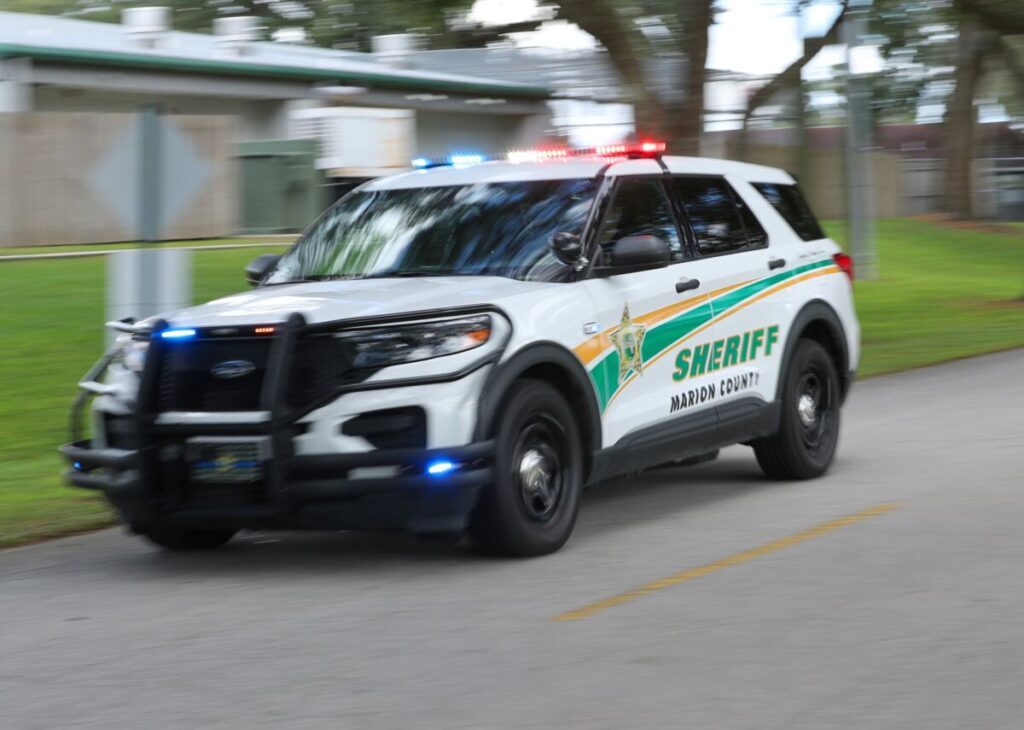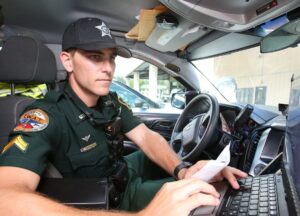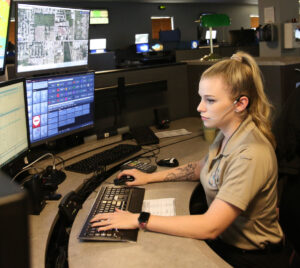MCSO response times covering Marion

File photo: A Marion County Sheriff’s Office vehicle responding to a call on Monday, Oct. 11, 2021. [Bruce Ackerman/Ocala Gazette] 2021.
Editor’s note: This series will explore the response times of Ocala Fire Rescue, Ocala Police Department, Marion County Fire Rescue, and the Marion County Sheriff’s Office. Officials will explain how their different departments track, analyze, and use response times as a tool to measure the success of their departments. Additionally, response times from each department will be examined.
The Marion County Sheriff’s Office (MCSO) is the county-level law enforcement agency tasked with serving the unincorporated areas of Marion County. MCSO prioritizes the 911 calls it receives into five different categories with priority-one calls being the highest and five being the lowest, according to Sgt. Paul Bloom, the Director of the Public Information Office for the Marion County Sheriff’s Office.
“So, we have calls that are prioritized one through five. Priority five is, somebody called me one time because there was a rooster walking through their front yard. They called 911 for that, and this person was legitimately scared of a rooster. It’s a legitimate fear, but we’re obviously not coming [with] lights and sirens,” Bloom said.
Lights and sirens are reserved for priority-one calls, said Bloom, and those are the calls that require the fastest response.
“We like to be there within the first five minutes, if at all possible,” Bloom states.
But he pointed out that, sometimes, considerations, such as the physical size of MCSO’s coverage area, factor greatly into their response times.

Sgt. Paul Bloom, the director of the public information office, drives a marked unit with it emergency lights turned on at the Marion County Sheriff’s Office in Ocala, Fla. on Monday, Oct. 11, 2021. [Bruce Ackerman/Ocala Gazette]
“Understanding that some zones, like when you look at our northwest district or even our northeast district, are very, very large. Our northeast district is almost 200 square miles, and we have a few deputies who are trying to cover that area. We may have just left a call in Salt Springs, and now, they’ve got to be all the way up to Orange Springs, so it’s a lot of distance we’re covering.” (The distance between Salt Springs and Orange Springs is approximately 20 miles.)
According to figures provided by MCSO, their average response time to priority-one calls in fiscal year 15/16 was 8 minutes and 12 seconds. In fiscal year 16/17, it was 8 minutes and 13 seconds. In fiscal year 17/18, it was 8 minutes, 9 seconds. In fiscal year 18/19, it was 8 minutes, 51 seconds, and in fiscal year 19/20, it was 9 minutes, 2 seconds.
It’s not just the distance that factors into higher response times, but also variables such as population density, Bloom offered.
“It [Marion County] is a 1,600 square-mile county that we cover. It’s very large and getting more and more populated. And anyone who’s lived here for a time knows there’s certain areas that are a concentrated population. Out the [SR] 200 corridor, or even down south towards The Villages, those areas are a little more densely populated than, say, something in the northeast or even far northwest. So, we do take all that into account.”
While running lights and sirens through the rural parts of the county is one thing, it’s another in the heavily populated areas, says Bloom.
“We don’t want to run lights and sirens through traffic unless we just have to because it’s very dangerous to drive through traffic like that,” he says.
“People say, ‘Oh, you can just get from here to there. No problem.’ It’s easier to go without the sirens and lights sometimes because when you turn on lights and sirens, a lot of times drivers don’t know what to do. And they’re right in your way, and it sometimes feels like it’s taking longer to get where I’m trying to go.”

Cpl David Christmas enters a ticket into a laptop in his patrol vehicle at the Marion County Sheriff’s Office in Ocala, Fla. on Monday, Oct. 11, 2021. [Bruce Ackerman/Ocala Gazette].
“The majority of our calls in any given day are going to be everything except the priority ones.”
In fiscal year 15/16, MCSO responded to 232,502 total calls, 5,524 (or .0237 percent) of which were priority one. In fiscal year 16/17, they received 245,871 total calls, 4,866 (or .0197 percent) of which were priority one. In fiscal year 17/18, there were 240,925 total calls to MCSO, 5,472 (or .0227 percent) of which were priority one. In fiscal year 18/19, MCSO responded to 217,167 total calls, 6,307 (or .0290 percent) of which were priority one. Finally, in fiscal year 19/20, they responded to 225,944 total calls, 7,582 (or .0335 percent) of which were priority one.
COVID-19 brought its own set of stressors, from lockdowns and stay-at-home orders to business closings and job losses. Bloom said there was a noticeable shift in certain types of calls once COVID hit.
“For us, what we saw last year was our domestic violence calls rose about 37 or 38 percent. That’s already a big call for us, and many times, those are priority-one calls if both parties are still there on a property at the house together, so we want to get there as fast as we can.”
Additionally, Bloom said MCSO also had to adjust when deputies would contract COVID and need to miss work. He said those times required healthy deputies to work overtime to cover shifts, and even though it was more work at times, all shifts got covered.
According to Bloom, MCSO has the county broken down into 11 distinct districts, and MCSO leadership regularly convenes with district brass to monitor the response times and make modifications as needed.
“They sit down once a month and look at all these things. Each district has its own district commander. All the district managers meet, and they sit with the sheriff and the chief, and they look at what they’ve got going on crime-wise and response times. [They also look at] the volume of calls and they say, ‘Hey, do we need to have more deputies patrolling this zone now? […] There’s less over here, we need more here,’ so they do that, and they make those adjustments.”
While all the agencies profiled in the response time series have similarities, such as call type priorities and metrics for response time measurement, each agency has its own set of considerations. While Ocala Police Department (OPD) responds to traffic accidents within city limits, Bloom pointed out MCSO does not respond to automobile accidents in the unincorporated areas of the county. Instead, Florida Highway Patrol responds, and MCSO will help with directing traffic, etc., if it is needed for the larger or more difficult accidents.
Like OPD though, Bloom said MCSO utilizes online reporting for certain types of calls.

Taylor Blanton, a dispatcher, works on a call in the 911 Communications Center at the Marion County Sheriff’s Office in Ocala, Fla. on Monday, Oct. 11, 2021. [Bruce Ackerman/Ocala Gazette]
Bloom also mentioned for lower-priority calls, MCSO tries to handle what it can over the phone.
“Somebody has a question, ‘Hey, how do I get a restraining order? How do I do this?’ And maybe something will be solved by phone, if we can we do that, because that speeds up their response time versus going out to the home.”
MCSO, also much like OPD and other law enforcement agencies, has a lengthy hiring process, according to Bloom, which can lead to delays in getting new hires ready for service.
“The hiring process is not really quick either because we do a very thorough background check. And so, once we get them hired on that day, and we’ve already done a month’s worth of background checking, polygraphs, all medical and psychological evaluations, and we give them a start date, it’s almost a year before they’re on the road, able to take a 911 call.”
Getting new deputies on the road is vital, Bloom says, because not only is Marion County geographically challenging to cover, but its population is growing fairly rapidly.
“It’s [the size of the county has] always presented a challenge, and we try to adjust to it, obviously. The only way to adjust to that is we add more deputies, as we try to keep up with the flow of the growth coming in. This county is expected to be a major county here, just within a couple of years population wise, so we have to stay focused on that.”
Until MCSO can grow their numbers, Bloom notes they will keep using whatever means they can to respond to all the calls they receive as quickly as they can.
“You know, if you have a county that has one and a half deputies per 1,000 citizens, that’s pretty good. If we have one per 1,000, it’s not as good, but that’s maybe an average, and we’re probably just below that. So, the way we account for it is, you try to work more efficiently using the tools that are available to us. We have a helicopter that we use…we also use the tools that we have in technology. We’ve reached out to our public by way of social media over the last few years, and that’s really saved a lot of footsteps for detectives that were having to go door-to-door and asking questions…but then yes, this is a growing county, and we have no choice but to add deputies, and that’s the goal of every agency in the state right now is adding deputies.”
While the population keeps growing, Bloom says the citizens of Marion County are constantly showing MCSO deputies how much they care.
“When somebody comes up and says, ‘Hey man, we appreciate you,’ just knowing that appreciation is there, that kind of keeps you motivated a little bit more and brings it back down to your focus on the big picture: [This] is why we got in this job in the first place, to help and just to enjoy the job, so [Marion County] is a good county to live and work in.”





